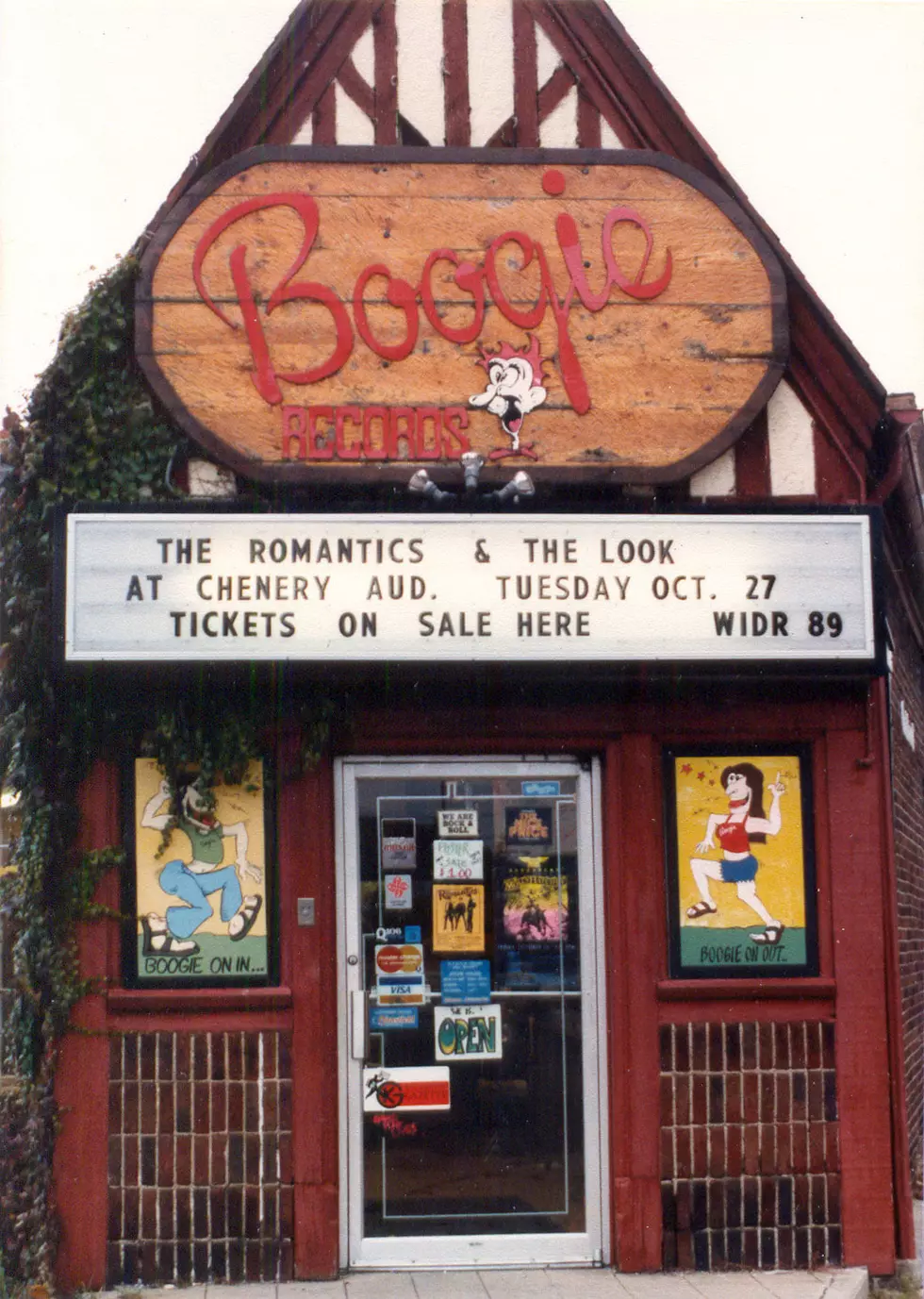
Letter From the Publisher
Published on Nov 29, 2025
Giving Thanks
Published on Nov 27, 2025
Garfield, Odie, and the Dead Vinyl Years
Published on Nov 4, 2025
How Doo Wop Saved Me
Published on Nov 2, 2025
More Liner Notes…
Featured Essay: A Love Letter to Boogie Records, the Stuff of Rock and Roll Dreams
by Kathy Passero

Boogie Records occupied a triangular peninsula that pointed like an arrowhead into the intersection of Stadium Drive and West Michigan Avenue, two wide and busy roads at the bottom of the hilly neighborhood where I grew up near Kalamazoo College. Like the parcel of land it sat on, the store itself resembled an isosceles triangle or, perhaps more fitting, the planchette for a Ouija board. The entrance was at the narrow point. Beyond it lay the stuff of rock and roll dreams.
To me, Boogie was a landbound Bermuda Triangle. Shrouded in mystery, vaguely dangerous, it held a cache of untold treasures, none of which I was allowed to explore because I was a kid, and my parents regarded the place with deep suspicion.
Whether you shared their wariness or considered yourself a devotee of the store, Boogie was universally acknowledged in Kalamazoo in the late 1970s and early 1980s as a counterculture mecca. Its mascot was Robert Crumb’s Keep on Truckin’ dude, its slogan “boogie on in…boogie on out.” Its bubble-letter Boogie logo was embellished with pupils in the Os that resembled bulging eyes. A pair of grotesque cartoonish dancing hippies flanked a sticker-covered glass door—another nod to R. Crumb and Cheap Thrills if you were old enough to remember Big Brother and the Holding Company, which I wasn’t. As a middle schooler, I figured the graphics were inspired by Wacky Packs trading cards.
Simply put, the store itself looked stoned. You could almost imagine it exhaling a cloud of fragrant weed through its front door.
The pothead vibe clashed violently with the architecture of the historic building that housed it—a whimsical English Tudor with a steeply pitched roof over brown-and-white half-timbering and red brick. Built in the 1920s by a noted local architect, it had served as a pharmacy and a soda shop in the years before Boogie Records shambled in and took up residence like a tie-dyed squatter.
I loved the incongruity. It reinforced the shop’s mystical allure. Lewis Carroll’s Alice in Wonderland meets Jefferson Airplane’s “White Rabbit.” Part charm. Part trip. Total fancy. Boogie seemed to embody every aspect of teen culture that lay beyond my experience, hovering just out of reach. Not only could you buy albums there, you could buy concert tickets. I’d never been to a concert, though I listened to WLAV and WGRD religiously and devoured Rolling Stone whenever I could get my hands on an issue. It was also rumored that you could buy drug paraphernalia there. (True. You could.) Hearing this cemented the store as Wonderland in my mind. I half expected to find a six-foot caterpillar smoking a hookah on an enormous mushroom when at last I turned 14, scraped together enough money from my crappy summer fast food job to buy some vinyl of my own, and worked up the courage to cross the Rubicon and boogie on in.
Too many rites of passage loom large in the imagination and let you down in life. But Boogie Records was every bit the Aladdin’s Cave I had envisioned. A downright decadent banquet for teenage senses. It felt alive and pulsing with the spirits of countless musicians whose music blasted from speakers in the corners. It smelled of incense and old cardboard, like a used bookshop. Broad swaths of the polished hardwood flooring was worn pale and rough by browsing music fans. (This place had history!) Hanging plants in white plastic pots hovered in midair like spiders on draglines. Posters of Bowie and McCartney plastered the walls. T-shirts dangled from hangers high above a long glass counter that held all manner of smoking devices, from bongs to one-hitters. Rolling papers nestled in a carboard box next to the cash register. Not that I knew what any of that gear was for. I’d never even heard the term head shop.
Infinitely more important, there were wooden bins upon bins upon bins of vinyl albums. White plastic record dividers bore label-maker strips with artists’ names. Some had been festooned with colorful Sharpie drawings of band logos, flourishes no doubt added by amateur artist-clerks with downtime. The Hot Lips logo delineated The Rolling Stones section. The rockabilly feline head with the slicked pompadour marked The Stray Cats section, right in front of Styx.
I don’t remember the first album I bought, but I was a Led head and Boogie helped me build my library of Zeppelin, a band whose arcane, cryptic album titles (or lack thereof) felt like the perfect purchase, a secret language I could finally speak. During my years in high school, I bought My Aim Is True, The Game, Escape, War, The Final Cut, Back in Black, The River, Making Movies, One More From the Road, and many more albums that I played so many times they crackled and popped like Rice Krispies in milk.
I bought concert tickets there, too—for bands from April Wine at Wings Stadium to a triple bill of Iggy Pop, Santana, and The Rolling Stones at the Pontiac Silverdome.
Some people said it was the beginning of the end when Boogie started carrying cassette tapes. Others prophesied its doom when the business expanded to a chain of stores. They were right. Eventually. By the late 1990s, Boogie Records was long gone from Kalamazoo, and so was I.
Today my album collection belongs to my daughter. At 22, she loves vinyl as much as I did, though she can’t understand why I cringe when she puts my beloved albums on her plaid retro suitcase of a record player, and her eyes glaze over when I wax poetic about Technics turntables and Bose speakers. It’s comforting to know that a few mementos of Boogie Records rock on, even without a component system like the one I coveted back in the ’80s. Watching her thumb through my old vinyl collection makes me wonder if Neil Young was right after all. Maybe rock and roll will never die. She pulls her latest fave out of its sleeve and places the needle at the beginning of side one, old school. I swear, I can almost smell the incense.
Kathy Passero is a writer living on the Upper West Side of Manhattan with her husband and two ungrateful rescue cats. Her work has been published in numerous national publications as well as literary journals. She writes often about travel, food, and trends, but this is her first piece on music. She’s still a Led head.

